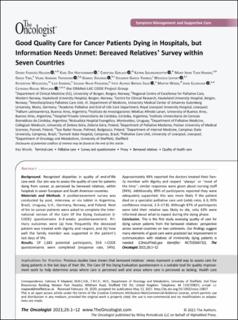| dc.contributor.author | Haugen, Dagny Renata Faksvåg | |
| dc.contributor.author | Hufthammer, Karl Ove | |
| dc.contributor.author | Gerlach, Christina | |
| dc.contributor.author | Sigurdardottir, Katrin Rut | |
| dc.contributor.author | Hansen, Marit Irene Tuen | |
| dc.contributor.author | Ting, Grace | |
| dc.contributor.author | Tripodoro, Vilma Adriana | |
| dc.contributor.author | Goldraij, Gabriel | |
| dc.contributor.author | Yanneo, Eduardo Garcia | |
| dc.contributor.author | Leppert, Wojciech | |
| dc.contributor.author | Wolszczak, Katarzyna | |
| dc.contributor.author | Zambon, Lair | |
| dc.contributor.author | Passarini, Juliana Nalin | |
| dc.contributor.author | Saad, Ivete Bredda | |
| dc.contributor.author | Weber, Martin | |
| dc.contributor.author | Ellershaw, John | |
| dc.contributor.author | Mayland, Catriona Rachel | |
| dc.date.accessioned | 2021-08-17T10:05:41Z | |
| dc.date.available | 2021-08-17T10:05:41Z | |
| dc.date.created | 2021-07-22T11:00:58Z | |
| dc.date.issued | 2021 | |
| dc.identifier.issn | 1083-7159 | |
| dc.identifier.uri | https://hdl.handle.net/11250/2768761 | |
| dc.description.abstract | Background
Recognized disparities in quality of end-of-life care exist. Our aim was to assess the quality of care for patients dying from cancer, as perceived by bereaved relatives, within hospitals in seven European and South American countries.
Materials and Methods
A postbereavement survey was conducted by post, interview, or via tablet in Argentina, Brazil, Uruguay, U.K., Germany, Norway, and Poland. Next of kin to cancer patients were asked to complete the international version of the Care Of the Dying Evaluation (i-CODE) questionnaire 6–8 weeks postbereavement. Primary outcomes were (a) how frequently the deceased patient was treated with dignity and respect, and (b) how well the family member was supported in the patient's last days of life.
Results
Of 1,683 potential participants, 914 i-CODE questionnaires were completed (response rate, 54%). Approximately 94% reported the doctors treated their family member with dignity and respect “always” or “most of the time”; similar responses were given about nursing staff (94%). Additionally, 89% of participants reported they were adequately supported; this was more likely if the patient died on a specialist palliative care unit (odds ratio, 6.3; 95% confidence interval, 2.3–17.8). Although 87% of participants were told their relative was likely to die, only 63% were informed about what to expect during the dying phase.
Conclusion
This is the first study assessing quality of care for dying cancer patients from the bereaved relatives’ perspective across several countries on two continents. Our findings suggest many elements of good care were practiced but improvement in communication with relatives of imminently dying patients is needed. (ClinicalTrials.gov Identifier: NCT03566732).
Implications for Practice
Previous studies have shown that bereaved relatives’ views represent a valid way to assess care for dying patients in the last days of their life. The Care Of the Dying Evaluation questionnaire is a suitable tool for quality improvement work to help determine areas where care is perceived well and areas where care is perceived as lacking. Health care professionals need to sustain high quality communication into the last phase of the cancer trajectory. In particular, discussions about what to expect when someone is dying and the provision of hydration in the last days of life represent key areas for improvement. | en_US |
| dc.language.iso | eng | en_US |
| dc.publisher | Wiley | en_US |
| dc.rights | Attribution-NonCommercial-NoDerivatives 4.0 Internasjonal | * |
| dc.rights.uri | http://creativecommons.org/licenses/by-nc-nd/4.0/deed.no | * |
| dc.title | Good Quality Care for Cancer Patients Dying in Hospitals, but Information Needs Unmet: Bereaved Relatives’ Survey within Seven Countries | en_US |
| dc.type | Journal article | en_US |
| dc.type | Peer reviewed | en_US |
| dc.description.version | publishedVersion | en_US |
| dc.rights.holder | Copyright 2021 The Authors | en_US |
| cristin.ispublished | true | |
| cristin.fulltext | original | |
| cristin.qualitycode | 1 | |
| dc.identifier.doi | 10.1002/onco.13837 | |
| dc.identifier.cristin | 1922400 | |
| dc.source.journal | The Oncologist | en_US |
| dc.source.pagenumber | e1273-e1284 | en_US |
| dc.identifier.citation | The Oncologist. 2021, 26 (7), e1273-e1284. | en_US |
| dc.source.volume | 26 | en_US |
| dc.source.issue | 7 | en_US |

